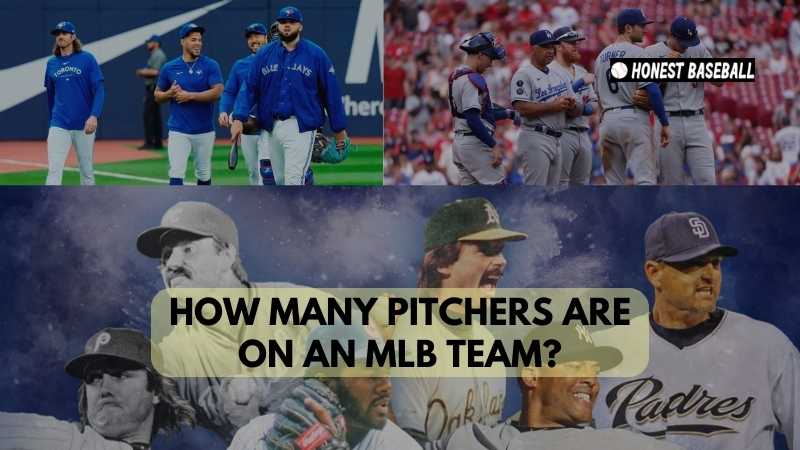Since the evolution of baseball, I have experienced so many things in Baseball. Among them, the most pressure I felt was while pitching.
Can you imagine how much mind game a pitcher plays while throwing the ball at the batter? Not only that, there are variations of pitchers since there are variations of pitches.
Now, you may have a question “How many pitchers are on an MLB team?” The rule says that as it used to be, the roster of 26 players can obtain 13 pitchers maximum. After COVID had gone, the 99-day lockout gave the teams a precaution about allowing 28 players on active rosters.
But is this all it is? Why once you can carry 13 pitchers maximum, and once you can carry 14? To answer all your questions, I have written this blog with the details. So, let’s get into action right now.
Who Are the Pitchers?
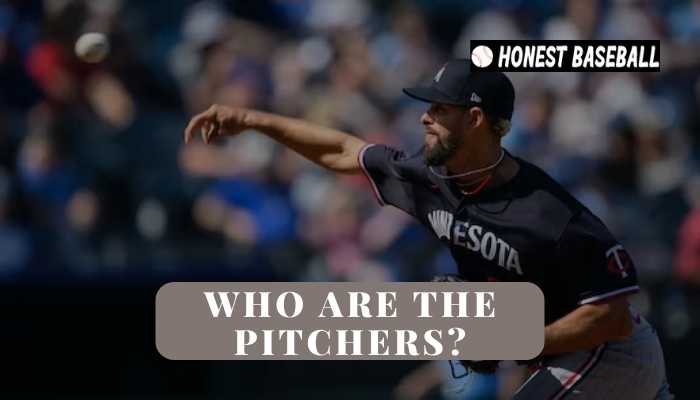
Many of you know about the pitchers already, as there are a lot of baseball fans out there. So, who are pitchers in a baseball game?
The pitchers are the players who pitch (throw) the baseball from the pitcher’s mound toward the catcher. Within this course, the batter has to hit that pitch, or they will be struck out if not hit once in the three chances.
Now, all the things a pitcher does is defend points. You may ask, how can a pitcher defend a point?
Did you forget? If a pitcher does not pitch, then how can the hitter hit? Furthermore, it all depends on how the pitcher pitches. If the batter hits the ball, then it comes to the other fieldmen who are here to rescue the point.
A pitcher plays a very crucial role in baseball. Without a good pitcher, you may ask for the rain of home runs. So, do you agree now why he is the essential player on the defensive side?
If you think the pitcher stops after their pitching has finished, then you are wrong. A pitcher must also bat and show their province by hitting 1s, 2s, 3s, home runs, etc.
Types of Pitching in MLB
There are so many pitchers out there that you can not count the number. But all those pitchers are bound into four basic types of pitching. They are –
- Fastball Pitching
- Knuckleball Pitching
- Breaking Pitching
- Changeup Pitching
Fastball
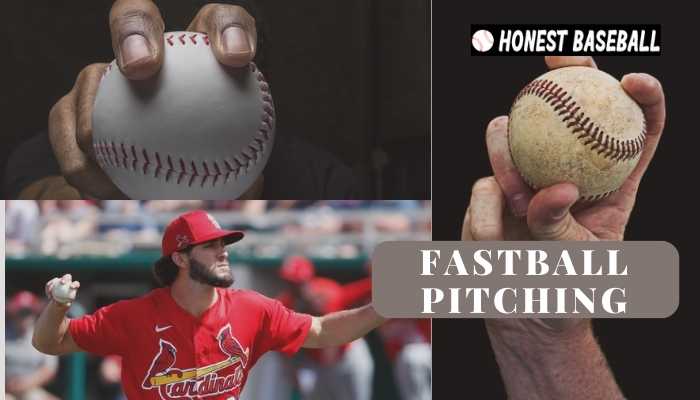
Origin: 1860 – 1870 (Approx)
Velocity: 92-105 mph
Renowned Throwers: Gerrit Cole, Jordan Hicks, Justin Verlander, etc.
Variations: Cutter, Sinker, 2-Seam Splitter
What do you think fastballs mean? Of course, it means speed balls. The fastball throwers usually just throw the ball as fast as they can, trying to blow by the batter.
When I got to learn about the fastball, I heard that this is the first and original pitch. The ball just kept getting faster as time passed by. What is the fastest ball current record in baseball?
It is 105 mph(miles per hour). It is what we calculate with the radar gun nowadays. Have you ever thought about the fastball’s speed before the radar gun came?
There are still many fastball users who have tarnished a lot of batters with the help of their fastballs. Now, in those fastballs, there are some variations. The straightest and the hardest ball thrown as a fastball is known as the classic four-seamer.
Then there is the cutter and the two-seamer. These guys move horizontally but just in opposite directions. Also, the balls are so fast that many bats were broken in the history of baseball, ultimately known for producing plenty of firewood.
If you think this is the end of the fastball, then you are unaware of sinker and splitter, the fastballs that drop. Many fastball pitchers love to use these different variations of fastballs. In fact, a ratio in 2019 shows that almost 60% of pitchers were fastballs.
Many people think a four-seam fastball and a two-seam fastball are totally the same. Well, I used to be one of that kind. But I now know the hidden differences between four-seam and two-seam. So, check them out if you want to understand them better.
Changeup
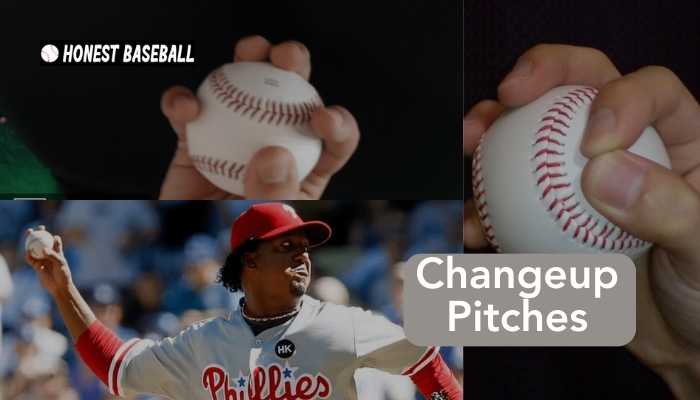
Origin: 1870 – 1880 (Approx)
Velocity: 70-90 mph
Renowned Throwers: Stephen Strasburg, Kyle Hendricks, Luis Castillo, etc.
Variations: Circle, Vulcan, Palmball, Splitter, Eepheus
If you want to be sneaky with the opponent, then try out these changeup pitching. The goal of a changeup pitcher is to throw off the hitter’s timing.
If you expect a 99 mph fastball and it comes in at 75 mph, can you swing by calculating the timing? It is impossible to do so because you are going to swing way in front of it.
I really like the guy Harry Wright who came up with this brilliant idea of throwing a ball that looks like a fastball but came up slow. And this was the change of pace in baseball, actually.
The more significant difference between the speed of your fastball and your changeup is, the harder it is to hit. I got this idea from Pedro Martinez, who could change his throws into a fastball and change up as much as he wanted.
There are several variations of pitchers of this changeup pitching. Among them, the splitter could be clearer. Moreover, you can learn from others too. If you can manage to throw them properly, batters will need clarification in the field.
Breaking

Origin: 1870 – 1880 (Approx)
Velocity: 75-93 mph
Renowned Throwers: Clayton Kershaw, Black Snell, Jacob Degrom, Max Scherzer, etc.
Variations: Slider, Curve, Slurve, Knuclecurve, Screwball
Think about a pitch that made the ball swing so severely that the commentator calls it “A nasty curveball”. Yes, I am talking about breaking ball pitchers.
A breaking ball is any pitch that primarily relies on movement that will deceive the batter. You will feel like the ball is coming straight toward you, but is it so?
While going towards the batter, the ball drops off the table at the last microsecond. Here, the concept of spin comes up.
The first pitcher who calculated it was 17 years old Jim Creighton. Ever since then, breaking ball pitchers are making batters look foolish.
Now, you may have heard about curveballs and sliders, but do you know their differences? Check it out so that you can dominate the field when others are making little from there.
Knuckleball
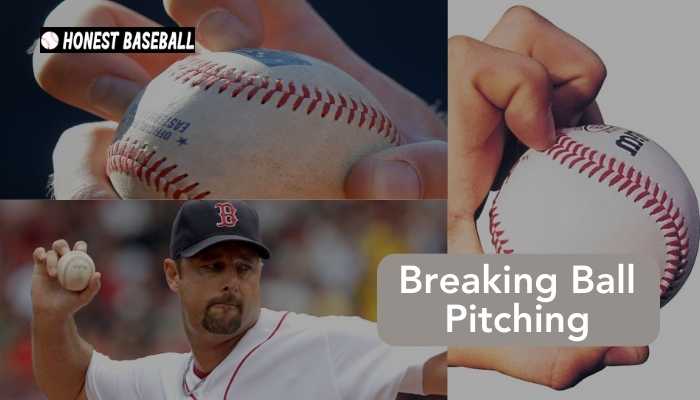
Origin: 1900 – 1910 (Approx)
Velocity: 65-80 mph
Renowned Throwers: R.A. Dickey, Tom Candiotti, Phil Niekro, Tim Wakefield, etc.
Variations: None
If you ask what types of balls are the oddest of all, knuckleballs. And the pitchers of knuckleballs are creative too. In short, the outcast of the pitching world is known as a knuckleball.
The butterfly with hiccups, the knuckleball. What is the reason why it is called knuckleball?
The reason behind naming it like this is that when you throw it, you see your knuckles upwards. When the ball wants to spin backward out of your hand as you are releasing it, the objective is to control the top half of the ball so that it comes out without any spin.
Now, do you remember what I told you about spin in the Breaking ball pitchers’ sections? That goes in a direction that the pitcher knows. But what if the pitcher throws a ball where he even does not know where the ball will spin? That is the kind of ball knuckleball is.
A good knuckleball pitcher may give you 0s a lot, but if it is a bad one, you will see home runs like rain.
How Many Pitchers Are on A MLB Team?
As it used to be, the roster of 26 players can obtain 13 pitchers maximum. After the COVID had gone, the 99-day lockout gave the teams a precaution about allowing 28 players on active rosters, leading the teams to get an extra pitcher (14 total).
I was really surprised to hear the news from MLB Communications. They posted a tweet sharing this announcement suddenly. Actually, it is meant to be done because pitchers go to injury after throwing some hard balls.
Can you throw 90-100 mph fastballs frequently? It is impossible to do so. So, think about the pitchers who are throwing these types of balls. That is why the MLB decided along with the MLBPA.
Now, as there are 13-14 pitchers on an MLB team, their roles are different too. Do you know those roles?
There are some significant roles of pitchers on an MLB team. They are –
1. Starting Pitcher,
2. Relief Pitcher,
3. Middle Reliever,
4. Lefty Specialist,
5. Setup man, and
6. The Closer.
1. Starting Pitcher
Starting pitchers are the starters of the baseball defensive team. That means if you are a starting player, you start pitching for your team when you go for defense. There are five starting pitchers maximum that can play in one MLB team.
For a significant portion of the time, you need to pitch in a game. I believe it is one of the most crucial tasks as you are the first to start everything.
Moreover, do you know that if you are a starting pitcher and played a game, then you need at least three to five days of rest? And that is the reason why one MLB roster keeps five starting pitchers on the team.
2. Relief Pitcher
If the starting pitcher is somehow unable to pitch, the relief pitcher, also known as the reliever, will go for pitching.
Let me give you an example so that you can easily understand it. Suppose I am the starting pitcher or the starter, and you are the relief pitcher. Now, if I cannot pitch because of some fatigue, injury, or other similar stuff, then you will be the one to pitch.
It is essential to get back to the heat that other players are indulging in at that moment. Relief pitchers come out of nowhere and start pitching. It is quite a difficult task to acknowledge that environment.
3. Middle Reliever
If you see a change of pitcher in the fifth, sixth, or seventh innings of a standard baseball game, that means the middle reliever or the middle relief pitcher is on the way. These pitchers’ role is to provide backup in the following innings stated above.
Now, that is what we see in a regular game. But in the National League, or Japan’s Central League, it is a bit different. You will see a middle reliever come right after the starting pitcher pulled in favor of a pinch hitter.
Middle relievers are used just to go for one or two innings. Other roles come afterward, the middle relievers.
4. Lefty Specialist
What comes to your mind when you hear the word lefty specialist? A person who is good at something in their left hand, right? A lefty specialist, also known as a left-handed specialist, is the same term.
A lefty specialist is a relief pitcher. The pitcher will throw the ball left-handed and is a deadly weapon against left-handed batters, weak right-handed batters, and switch-hitters.
Jesse Orosco was a great example. In his baseball career, he used to be a relief pitcher, who gradually became a left-handed specialist later in his pitching career.
If you want to become Orosco, then you should practice left-handed pitching properly because it is way more complicated than how easy it looks.
5. Setup Man
A setup man has a lot of names. When I first learned about it, I thought this dude had a lot of roles. But then I understood the reasons why a setup man has so many names.
A set-up man, also known as a set-up man, setup pitcher, or setup reliever, is a regular player of a team who pitches before a closer. The role of a setup man is crucial because the 8th and the 9th innings are too much pressure when your team is one or two points behind.
These pitchers are mostly known as the second-best relief pitchers after the Closer. I will discuss more about the Closer in the later section because the Closer will do his job after the condition that the setup man makes. So, the Setup man has a big role.
You will not even believe how much a setup man is valued. If the setup man succeeds in his career of pitching, he gets promoted to a Closer. I really admire the setup man for his long-lasting effort in the last innings.
6. The Closer
In the formal definition, a closing pitcher, in short, a closer (CL), is a relief pitcher specializing in getting the final outs in the last innings of the game. In short, the last pitcher of the game to make the win for their team.
When I still used to be a regular pitcher in the 1990s, people used to call this role different names. They are such as short relievers, stoppers, and sometimes the fireman.
Without the closers, many games could have gone on the other teams. One of my matches was just like this. We were only 2 points ahead. In the very last inning, the opponents were already one at second base; another one was at first base.
We needed an excellent pitcher to do it. Then our closer came to the field. I will never forget that time. The more intimate threw the balls. Strike, Strike, Strikeout! Three times in a row!
Because of the closer match, we won that match. I was thrilled with the score. We never thought we would win that game, but we did it thanks to our closer. That is the reason why I think the closer is one of the most essential participants in the game.
Why Need Different Pitchers?
There is a saying that a person can learn how it comes if they see it more and more. What if you have only one pitcher? Will it be efficient?
The reason for having different pitchers in the rotation. It helps them to confuse the hitters with different types of pitches that you have seen above.
Moreover, one pitcher can’t throw balls for the whole innings. They need rest too. If there are any injuries to the pitcher, then the team will be at stake.
That is the reason why different pitchers are needed in the field while playing a baseball match.
Frequently Asked Questions
1. How Many Pitchers Does a Bullpen Have?
A well-deployed seven-pitcher bullpen allows a team to carry an extra bench hitter, while some clubs have eight or more relievers. It can be an advantage for the bullpen.
2. How Are Roster Decisions Made for Pitchers?
Many factors make the roster decisions made for pitchers. They can be the pitchers’ performance, pitch repertoire, pitchers’ health, and game strategy. They all are needed to handle different situations in a game.
Final Thoughts
Baseball players play hard to produce quality plays for the people. While the pitchers are trying to strike out the hitters, the hitters are trying to make home runs.
By learning how many pitchers are on a baseball team, you can be assured of how to make those pitchers play because you know the secret recipe for confusing the batters.
That is why making effective plays is an essential part, where pitchers are the game changers.
Check Out Some Latest Updates about Baseball
Kauffman Stadium Bag Policy 2023 – Even More Strict Now!
Baseball Fielding Drills | Practice With Coach Jason
Fun Facts
100 Fun Facts About Baseball: Get Ready To Be Astonished!
Here Are Some Of The Funniest Moments In Baseball History (They Will Surely Make You Laugh Too!)

Hello everyone. My name is Jason Butler, and I live in California, America. I was a professional AAA Minor League Baseball player. I lost my chance of playing MLB for injury issues, but I did not lose my love for baseball. I attended the coaching training program and am now working as a coach in a small school in San Diego.
I always love to share my experience and knowledge if that can help you. Play baseball, and stay fit.
